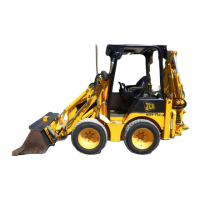13 - 4
Dismantling and Assembly
The numerical sequence shown is a guide to dismantling. For
assembly the sequence should be reversed.
Dismantling
Note: Later motors are fitted with Eslock type bolts 3 which
are wirelocked. When early motors are dismantled the later
type bolts must be fitted and wirelocked. The bolts must
always be renewed whenever a motor is dismantled. New
bolts and lockwire are supplied as part of the replacement
seal kit.
Note: To gain access to the brake only, remove bolts 24, do
not disturb bolts 3.
After removing plug 1 and washer 2, place the unit in a
holding tool or jig with housing 4 uppermost.
Mark relative positions of housings 4 and 25 and outer gear
20 to ensure correct position on re-assembly.
Housing 4 and channel plate 5 should be removed together
and placed on a clean area of the bench. Remove guide pin 6
before separating the channel plate from the housing.
To remove the balance plate 7 from housing 4, first remove
spacer 8, then fill the hole with grease (to act as a hydraulic
piston). Press a mandrel into the hole and force out the
balance plate.
Before removing inner gear 18 mark its position in the outer
gear 20 to ensure that it is returned the same way upon
assembly.
Keep all parts of the gearwheel set 17 together after removal.
Do not mix gearwheel parts from different motors.
Before dismantling the brake assembly, seal the hydraulic
port 23 to prevent ingress of dirt. Mark the position of the
flanges to ensure correct assembly.
Keep brake friction plates 30 and discs 31 together as a set.
Discard all seals and 'O' rings. Any bearings removed must
be renewed. Clean all parts in low aromatic kerosene.
Note: Fretting between the housing flanges is acceptable
provided that components are assembled in the same relative
positions.
Assembly
Note: Soak new brake plates in oil for 1 hour before
assembly.
Before assembling, lubricate all parts with oil. Grease all seals
and 'O' rings with Vaseline.
Ensure bearing 44 is pressed fully onto the shoulder of shaft
29.
When fitting bolts 24, tighten them in sequence to avoid tilting
the bearing 28.
Do the following to ensure correct alignment of the gearwheel
set components:
a Mark any spline peak on the inner gear 18 that lies
across a valley of the lobes as at F.
b Mark the bottom of a spline tooth on the valve drive 10
as at G.
c On disc valve 11 select a trough aligning with any outer
hole (eg. H) and mark the next peak to the left as at J.
d When the disc valve 11, valve drive 10 and inner gear 18
are assembled, all marks must align.
Note: Failure to follow the above procedure could result in the
motor driving in the wrong direction.
When assembling outer gear 20 to housing 25 ensure that
holes A are aligned.
Using Vaseline on spacer 8 will prevent it dropping out during
assembly.
When fitting bolts 3, torque tighten initially to 145 - 155 Nm
(107 - 114 lbf ft; 14.8 - 15.8 kgf m) then slacken one half turn
before tightening to the correct torque specified below.
Wirelock bolts in pairs as shown at B.
Fill the assembled motor with the correct oil (see Lubricants
and Capacities in Section 3) before fitting to the machine.
After fitting to the machine, run the motor for a few minutes
with the wheels raised off the ground. This is to circulate oil
through the motor prior to operation under load.
If the motor is to be stored, or fitted but not connected for any
length of time, it is advisable to fit plugs to the brake and
motor connection ports.
Torque Table
Nm lbf ft kgf m
3 (see text) 4 off 135 - 145 99.5 - 107 13.8 - 14.8
1 1 off 30 - 60 22 - 44 3 - 6
33 4 off 31 - 39 23 - 29 3.2 - 4.0
24 8 off 31 - 39 23 - 29 3.2 - 4.0
Port plugs 4 off 5 - 10 3.7 - 7.4 0.5 - 1.0
Section E Hydraulics
9803/8550
Section E
13 - 4
Issue 3*
Drive Motors
*

